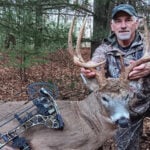It’s not too often you see a buck in full velvet come hunting season in Pennsylvania, which is why Ray Yuran, of Mercer County, was confused about the coloration of the antlers of the buck trotting across his food plot on first day of archery season. “They looked reddish,” he said, “like the color of blood. I thought maybe it had just finished shedding its velvet.”
In fact, the buck’s antlers still had their velvet, and the red color was simply caused by the way the sunlight reflected off of them. That night, Yuran asked his son Justin to do some research about why a buck might retain its velvet long after other bucks have shed theirs. During the research, Justin repeatedly encountered the word “cryptorchidism.”

The fuzz from a Cryptorchid buck.
Cryptorchidism is a condition that occurs when the buck’s testicles, for whatever reason, remain in the abdominal cavity and fail to drop into the scrotum at the proper time. During extreme cases, they never descend. In other instances, when they do drop, they often appear small and malformed. Literally translated, cryptorchid means “hard-to-find testes.”
Cryptorchidism has nothing to do with genetics. It appears randomly in whitetails, and even bucks that are born perfectly healthy can become cryptorchid bucks if their testicles become damaged at any point during their lives, such as from a fight with another buck or (gulp!) by not jumping high enough to completely clear a fence. Any number of factors could play a role, but the effects are the same. The buck experiences a dramatic drop in testosterone.
Generally speaking, a healthy whitetail buck receives a natural boost in testosterone levels when the days begin to shorten in late summer. Blood flow to the velvet diminishes and calcium from the buck’s skeleton is transferred to the antlers to make them harden. All of this occurs roughly 30 days before the buck actually sheds its velvet. Cryptorchid bucks, on the other hand, never receive that initial boost in testosterone and, therefore, never exhibit normal buck behavior, such as making rubs and scrapes. In essence, they become more like the females of the species.
Yuran took particular notice of that last fact and decided that he would hunt this unique buck the same way he would hunt for a doe. On October 2nd, the first Monday of archery season, he found the trail the deer was using to enter the food plot every evening and set up about 20 yards downwind of it. As predicted, the deer appeared on the trail a half-hour before dark and Yuran took advantage of the opportunity to harvest a once-in-a-lifetime deer that green scores nearly 160 inches.

Yuran with his buck of a lifetime.
“When we recovered the deer,” said Yuran, “we rolled it over and, sure enough, its nuts were about the size of almonds and its penis was only as big as the tip of your pinkie finger.”
What actually happened to the buck, though, remains somewhat of a mystery. After all, Yuran had trail camera pictures of the deer from previous seasons that showed the buck without velvet, the most recent being February 2017. In that photo, the rack appeared the same as that of any normal buck. What happened in that eight-month span?
One possible explanation concerns the age of the buck, estimated to be 4.5 years old, at the time of the harvest. Despite the undersized testes, it’s possible that the buck was still able to produce enough testosterone to go through the typical cycle of growing and shedding antlers during its previous four years of life. However, upon reaching maturity, testosterone production had likely diminished enough to finally disrupt that process.
Even testicles that have not descended into the scrotum can function on at least some level. If they are developed and produce enough testosterone, the deer will shed its velvet and display a polished rack throughout the fall. The scrotum appears empty and barely noticeable on these cryptorchids, which is why they’re often referred to as antlered does. True antlered does, however, never receive the late summer spike in testosterone that makes them want to rub trees. Therefore, true antlered does will remain in velvet year-round as well as never shed their antlers.

The author admires a cryptorchid buck taken in December.
Also, true antlered does still carry out the same life cycle as normal does. They breed, give birth, and raise fawns. Cryptorchid bucks, on the other hand, are incapable of mating. Their unusually low testosterone levels create a lack of desire and motivation to breed or become dominant. They never rub trees or make scrapes or exhibit the ritualistic rutting behavior of normal bucks.
As cryptorchid bucks age, they retain their antlers year-round but never shed their velvet. And they never stop growing. The antlers of very old cryptorchid bucks tend to develop abnormal points and deformities which give them a “cactus” appearance – hence the term “cactus buck” has been coined to describe these cryptorchid geezers.
Perhaps the largest cactus buck on record was found dead by Lionel Crissman in Ohio in October 1989. Nicknamed the “Barnacle Buck,” the deer’s antlers sport literally hundreds of points, of which 72 are said to be “scorable,” meaning they’re at least one inch in length. Although the rack is a mainframe 7-point, it net scores an unbelievable 257 4/8 inches.
In order for the rack of a cryptorchid buck to be officially scored, all of the velvet must be stripped from its antlers, which is something Ray Yuran is unwilling to do with his 2017 trophy. “I don’t care about the record book anyway,” said Yuran. “This is a once in a lifetime buck. The velvet is what makes it so unique.”

 By
By 



